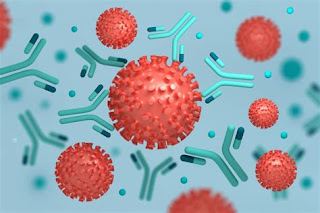It may seem that things have gone very quiet on the vaccine front, but this has not been the case. 23 vaccine candidates have entered clinical trials in the five months since the pandemic arrived, and now the first encouraging report has been published.
 |
| Antibodies vs Sars-Cov2-19 |
It was with incredible speed that phase 1 trials to establish safety, dosage and formulation were started. The usual time from identification of a viral genome to phase 1 trial is 3-9 years. The first vaccination in this trial was given after 66 days on the 16th March.
The trial is called the Moderna trial, after the biotech company behind it, in co-operation with the National Institute of Health in the USA and took place in Seattle and Atlanta.
The researchers have reported the preliminary results on the 47 subjects who were vaccinated back in March and the results seem very encouraging.
The trial
The 45 people in the trials were given two vaccinations 28 days apart, and three different doses were trialled. The vaccine consists of altered viral RNA coding for a protein on the infamous spike of the Sars-Cov2-19.
It is wrapped up in a lipid nanoparticle, rather like a microscopic envelope, and injected into the deltoid muscle whose genetic machinery then generates a protein antigen similar to one of the proteins on the spike of Sars-Cov2-19. The immune system then generates the antibodies which are active against the virus. Clever stuff!
What happened?
The participants all generated enough antibodies to suggest effectiveness against COVID19, with the middle dose achieving the best balance between side effects and effectiveness. Of course, they don’t know how long this will last, but 57 days later, at the time of publication, the levels are still adequate for protection – so far so good!
Side effects were common, with fatigue and chills affective 80%, headache in 60% and muscle pain in half of those given the middle dose, but all were reported as mild or moderate in severity and transient.
Further reports are due on the effects in the crucial over 55 age group and of course, how long the antibody response persists. There is a larger second phase trial proceeding as we speak and a larger phase three trial to start at the end of July.
Naturally, the trial volunteers simply have the treatment and go away, to be followed up with blood tests and their side effects monitored, so time will tell.
The researchers conclude;
The mRNA-1273 vaccine induced anti–SARS-CoV-2 immune responses in all participants, and no trial-limiting safety concerns were identified. These findings support further development of this vaccine.
What next?
There will be more reports from this trial as time goes by, in particular with older participants, and of how the antibody response persists.
Phase 2 will be to look at the effectiveness on a larger group of a few hundred individuals including the more at risk older groups. Phase three will then look at a larger population based study of the finished product in what are usually randomised controlled trials of effectiveness in the real world.
I’m curious to know how and indeed, where this phase 3 trial will be performed. Brazil looks the best place right now. This is because the more people vulnerable to the virus, the more the benefits, or otherwise, of the vaccine will be evident. There have been calls to intentionally infect volunteers to test the effectiveness of the vaccine directly.
Potentially, the vaccine could be ready in 6-9 months. Moderna (naturally) are optimistic stating that: “the Company remains on track to be able to deliver approximately 500 million doses per year, and possibly up to 1 billion doses per year, beginning in 2021.”
Of course, by then we will be heading into the new year, which in terms of the pandemic, and this difficult year, seems a long time away. By then we will have a good idea how the virus and us, its hosts, are behaving in the winter of the northern hemisphere with all the challenges that will bring. (I’m keeping my fingers crossed that we are lucky with flu this year.)
We must not underestimate the many significant hurdles to be overcome before any of us call our GP or the chemist for a coronavirus jab, but the first hurdle has been overcome. I feel sure that there will be a flurry of these papers soon with more results on the way.
We with the publication of this paper, we are one step nearer to a vaccine which will signal hope for effective prevention against COVID19.
